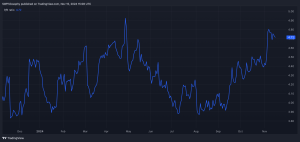Nvidia Corp. may have found a sweet spot for a gaming card that delivers close to pro performance at a reasonable price following the release of its Ada Lovelace architecture cards.
On Wednesday, Nvidia
NVDA,
-1.57%
launched its RTX 4070 card at a manufacturer’s suggested price of $599 — $1,000 cheaper than its monster top-of-the-line RTX 4090, which was criticized for being too expensive when it was first introduced.
Read:Nvidia market share surges with gaming-chip market ‘on the mend’ and boosted by AI, analyst says
The 4070 includes DLSS 3 neural rendering, real-time ray-tracing tech and the ability to run most modern games at over 100 frames per second at 1440p resolution, the chip maker said.
Ray tracing was a novelty back a few years back and only a few games took advantage of the technology, but Nvidia said that hundreds of games now use it.
“Today’s PC gamers increasingly want super-premium visual experiences, with 83% of GeForce RTX 40 Series desktop gamers enabling ray tracing and 79% turning on DLSS, a revolutionary breakthrough in AI-powered graphics that massively boosts performance, now in its third generation,” Nvidia said in a statement.
Those high frame rates are maintained through Nvidia Reflex, “which reduces input lag between devices and monitors,” the company said.
Boards will be available from such manufacturers as Asustek
2357,
+1.83%,
Gigabyte, MSI and PNY, Nvidia said.
Going up against cards from Advanced Micro Devices Inc.
AMD,
-1.85%,
the RTX 4070 appears to be most comparable to AMD’s RX 6800, which is priced at $579.
Nvidia launched the RTX 4070 Ti for $799 in January, and the 4090 was launched back in October.
Nvidia also has the 3060Ti for $399, the 3060 for $329 and the 3050 for $249, as well as the RTX 4080, which is priced at $1,199.
Nvidia shares are up a whopping 86% this year, while the PHLX Semiconductor Index
SOX,
-0.73%
is up 22.8%, the tech-heavy Nasdaq Composite
COMP,
+0.08%
has risen 15%, the S&P 500
SPX,
+0.32%
has advanced 7% and the Dow Jones Industrial Average
DJIA,
+0.46%
has risen 1.6% in the same time frame.
This post was originally published on Market Watch






